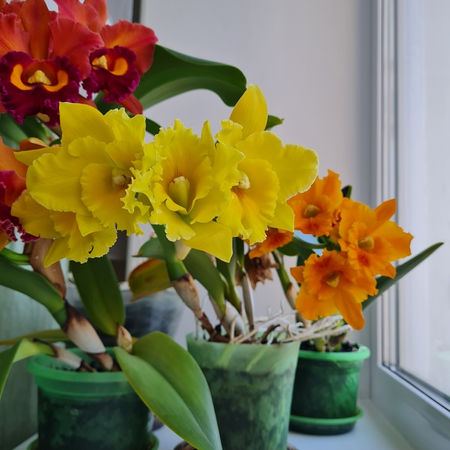
CATTLEYA
(KAT-lee-ah)
Cattleyas are among themost beautiful of orchidflowers. Often used incorsages and wedding bouquets, their bloomscan last several weeks to a month or more.
Miniaturecattleyas have increased inpopularity because oftheir ease in growing onwindowsills in the home.
Cattleyas store water in both their pseudobulbs and their roots. Miniature catts and seedings need more frequent watering than the larger standard catts because they store less water.
Potted in a bark mix (finer bark for the smaller catts and seedlings), the mix should be allowed to dry out before re-watering. Summer months and active growth periods will require
More frequent watering. After a few waterings, you will be able to tell by the weight of the pot whether or not it is time to water again. If in doubt, wait a day. Generally, watering once a week to ten days is sufficient for large cattleyas; seedlings and miniatures need water every five to seven days.
When watering, place the plant in the sink and use tepid water. Do not use salt-softened or distilled water. Let the water run through the plant for a minute or so. Be sure to let the plant drain completely.
When watering plants, it's a good time to look closely for any sign bf insects or disease.
Light
Catts belong to the 'high' light group of orchids. The bright light of an east or west window is ideal; south windows can also be used if shaded with a sheet curtain. The leaves should be medium green. If your plant is not blooming for you, try increasing the light. Without sufficient light, a cattleya will not bloom.
Temperature
Catts generally enjoy warm temperatures; ideally 55-60F at night and 70-85F during the day. Mature plants do well with a 15-2O-degree difference in day and night temperatures. Keep in mind that temperatures close to the window on a windowsill will be colder or hotter than your general house temperature.
Fertiliser
Any balanced orchid fertiliser, for example 20-2O-2O (found on the label) can be used to fertilise your orchid. Feeding weakly (l/4 strength) works well for catts. Once a month, use clear water to flush any accumulated salts from the potting mix. Increase the fertiliser to % strength when the plants are in active growth.
Tips
Use a shallow tray of pebbles filled with water to increase humidity around your plants. Be sure the pot does not sit in water, as this will rot the roots. Give your plants room for air to circulate around them. Crowding of plants can lead to problems with insect infestations and Fungus. A small fan will help provide good air circulation around your plants.
When the blooms are finished, remove them from the plant. Continue watering and fertilising, and within a year, it will begin the blooming cycle again! Cattleyas should generally be repotted every two or three years, either after flowering or in the spring.
Information gathered from the American Orchid Society www.aos.org




